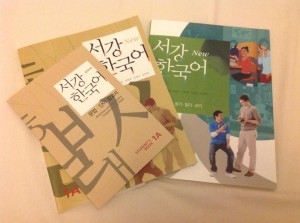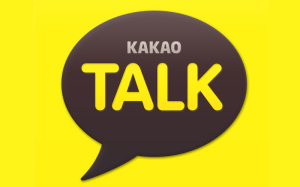I’m not even close to fluent in Korean, and I’ve only been learning for a couple of months, but I’ve made a lot of progress and as a result a lot of people ask me where I learn Korean and what resources I use. So I’ve decided to make a blog post about how I go about studying and hopefully it’ll help others who are trying to learn too!
1. Apps
The first thing I did when I decided to study Korean properly was download some apps for my iPad (the two I have are pictured above). I mainly use the first app ‘Learn Korean’ and have upgraded it to access the full vocab list (which cost only £2.99 if I remember rightly). There are actually a couple of mistakes in both apps, but nothing that will damage your Korean learning, and you’ll probably notice them straight away. So how do you use the apps to study? Basically, what I do is I write out all of the vocab from one section – just the hangul and English – and once I’ve finished noting it down, I go back and research it all. So say there’s the phrase ‘화장실이 어디에요?’ (Where is the toilet?) – which does come up many times in the app – then I take that phrase and break it down and learn the meaning of each part. Like so;
“화장실이 어디에요?”
(화장실)(이) (어디)(에)(요)?
(화장실) – Toilet (이) – Subject Marker* (어디) – Where (에) – Place Marker** (요) – Honorific***
*A subject marker defines what the subject of the sentence is, and in this case it’s the toilet.
**A place marker indicates where something is happening or where something is at.
***Honorifics determine how polite your speech is, 요 is neutral polite.
Of course, if you’ve just started learning you wont know what each part is, so you research it. Google is most definitely your friend here, and I don’t mean Google Translate. Searching ‘이 meaning’ or ‘이 grammar’ will immediately pop up with resources that explain the meaning to you. Naver Dictionary is also your friend here. When you research, take note of the sites that are most useful to you, so you can reference them in the future.
Now that you’ve researched all your new vocab, it’s time to reinforce your knowledge and make sure you’re not just mindlessly jotting down vocab you won’t remember. That means it’s time to make flashcards! The easiest thing – and cheapest thing – to do is to neatly tear up some paper and write the Korean on one side and the English on the other. I wrote the Korean in Hangul, but if you want someone who can’t read Hangul to help you, then I would recommend writing romanised or creating a second set of romanised flashcards if you have the time. Then you can practice with your flashcards as many times as you like, until you’re satisfied with your knowledge. Make sure you practice guessing the Korean meaning of the English words as well as reading the Korean and guessing the English. Knowing what the Korean is from reading the English meaning is a lot more difficult, but if you practise both ways you can ensure you won’t have gaps in your knowledge!
I only studied seriously like this for a week, but that’s where most of my Korean knowledge has come from, it provided a good basis for later learning. Since that first week, I haven’t worked from the apps very often, but I do practise with flashcards still and create little tests for myself based on those app units to make sure my knowledge is up to scratch. When I study, I go all out 🙂
2. Research
Naver Dictionary
I already mentioned researching the vocab from apps, but just as a general rule of thumb, if you hear or see a word you don’t know – perhaps it’s something you hear often in songs – then look it up and jot down the meaning for future reference.
Although, of course there are multiple meanings to most words, so you can always write down a couple of other meanings if you like, but for me, I just write down the meaning that fits the context I heard it in. If you write down too many meanings, you may confuse yourself, especially if you don’t need to know most of them yet. Don’t overload your mind!
3. Textbooks
Sogang Korea 1A
I’ve only recently began using the textbooks I bought not long after beginning my studies. I bought the ‘Sogang Korean’ 1A textbook, workbook and grammar/vocab supplementary book. These 3 books cost me around £50 (Approx $80) and I bought them from Amazon brand new, but I’m sure if you shop around the web you can find cheaper copies, even if they are second hand. However I would recommend buying them brand new, especially the workbook, as it has boxes for you to write in on the textbook itself. I like to write in the book rather than writing it all out, not just because I can be a bit lazy, but also because it puts it in context with the questions and so on.
Sogang Korean textbooks are a little confusing to use outside of a classroom setting, but for anything a teacher can’t explain, I research it and learn the meanings just as well as if I were in a real class. The workbook has a lot of pages of Hangul writing practise too which is useful for beginners. For me, I already knew how to read and write before knowing what anything actually meant, so I skipped that section of the textbook. My handwriting in Korean is actually neater than my English handwriting, so I guess it’s the English alphabet I need practise writing…
The grammar and vocab supplementary book is extremely useful, and also since it’s compact, you can take it around with you and learn on the go. Learning vocab is incredibly important, but grammar is what gives you the ability to make coherent sentences in Korean. After all, if someone was hungry and only knew how to say apple, but not how to ask for one, it would be a little difficult. Sure you can use body language to illustrate points in replacement of grammar, but I wouldn’t say I’d recommend roaming Korea pointing at things, so it’s best just to study a little more!
Anyways, the textbooks are really useful, but I’ve only taken up using them properly in the last week or so, so I can’t give a solid judgement on them yet, but so far so good! However, I do feel like I’ve learned more from cheap or free resources though. So if you don’t have the money to purchase textbooks, I wouldn’t worry too much as you’ll find you can learn just as well without them. But they are a big help if you can afford them. So they’re not necessary, but they’re good to have.
4. Talk To Me In Korean
TTMIK are undisputedly one of the go-to sites for people learning Korean. Their resources are great and cater to different types of studying; you can listen to their podcasts or you can read their PDFs, whichever suits you. Personally, I’m more of a reader than a listener. I usually use TTMIK’s lessons to see what I know and don’t know. For example, I went through all their Level 1 lesson PDFs the other day and noted down any vocab that I didn’t know. So I use the site to reinforce my knowledge base and expand it, rather than it being the foundation of my Korean knowledge. This is because I use so many different resources, but you’re more than welcome to study only through their lessons. However, you’ll find you’ll learn more if you check out other sites, apps and so on and others include extra vocab that each other may not have.
Their site is very easy to navigate and everything is explained clearly, which is what makes it especially appealing to the younger audience who are learning Korean. They’re definitely target K-pop fans who are learning Korean, as they have started interviewing K-pop artists. So far, they’ve interviewed A-PRINCE and Infinite’s L. A couple of other sites I’ve noted down to reference are HowToStudyKorean, TheKoreanClass and KoreanChamp. Add them all to your bookmarks for later!
5. KakaoTalk
I often speak to my Korean friends on KakaoTalk, and recently I’ve made a deal with a couple of my friends that they can only use English and I can only use Korean so we can both improve. Then, if I make any mistakes, or they do, then we correct each other and therefore improve even more. By talking on Kakao, it puts my knowledge into use and makes sure that even if I’m not studying all day every day, I’m not just going to forget how to speak Korean.
If you don’t know anyone that is Korean or speaks Korean fluently, then get yourself over to a penpal site such as Interpals and make some friends! There are many people on penpal sites looking for language exchanges, in fact on Interpals that’s something you can specify on your profile, and so of course there are Koreans looking to improve their English like you are looking to improve your Korean. If you get along well with you penpal, you have both a language exchange partner and a new friend, which is always a good thing.
6. Facebook and Twitter
What do you mean Facebook and Twitter can’t teach you languages? Of course they can’t, but they are extremely useful tools for practise. For example, I often post statuses and tweets in Korean. Whilst this has proven to be irritating to my friends that don’t speak Korean and have no intentions of learning (suck it up guys), it’s also proven to be a huge help to me in articulating the vocab I know. Perhaps I know how to say ‘I’m’, ‘going to study’ and ‘today’, well voila, I also know how to say ‘I’m going to study today’. Facebook and Twitter are where people post their random thoughts most of the time, so try and see if you can say those random thoughts in Korean. And if you find you’re lacking a word or two, it’s time to learn it! So through this process, you’re expanding your vocab range further.
Also, if you have Korean speaking friends on Facebook, they’ll probably point out if you make mistakes and correct you. Score! Whilst it’s a little embarrassing to have your mistakes pointed out in front of Facebook or Twitter, it’s only going to improve your Korean and stop you making the same mistakes in the future.
7. Korean Media
Korean media, such as the news or even just TV shows is great for learning too. To practice my handwriting – even though I skipped those handwriting sheets – I write out Korean news articles from Naver. You may notice as you learn more, that whilst you write down articles, you run through the words in your mind and you may actually get the jist of what the article is about. This happened to me recently!
KBS World are useful as they subtitle all of their TV shows – except the live news. You’ve probably heard before that watching as much Korean TV as possible will help you pick up more words, and it’s true. It’ll help your listening abilities and you’ll start to hear the words you already know. Try watching the news, and see how much you can understand without subtitles. KBS World actually have a live stream app, so give that a download and you can watch it where ever you have internet!
——–////////////////////——–
And I believe that’s pretty much what I do to learn Korean! It seems like a lot, and I guess it is, but remember you’re untaking learning an entire language. We often take for granted that we are fluent in our first language or whichever languages we’ve been brought up to learn. By studying by yourself, you realise how much there really is to it. It’s no easy task to learn a language, especially if learning languages isn’t really your forte. But don’t worry, the more you practice, the more you’ll learn! Hopefully we can all converse together in fluent Korean some day 😀
**Crossposted from Freyabigg.co.uk**


![[TIPS] How to self-study Korean](https://unitedkpop.com/wp-content/uploads/2013/08/learn_korean1.jpg)






![[Iconic Idols] Harisu](https://unitedkpop.com/wp-content/uploads/2023/06/allkpop_1615172843_20210307-harisu-214x140.jpg)
![[Idol Spotlight] NoSo – Korean’s suburbian star](https://unitedkpop.com/wp-content/uploads/2023/05/000047330030-2-1000-0x195x1078x718_q85-214x140.jpg)
![[OP-ED] Who pathed the way? A deeper look into the history of K-pop Part. 1](https://unitedkpop.com/wp-content/uploads/2023/04/healthy-food-1-214x140.png)